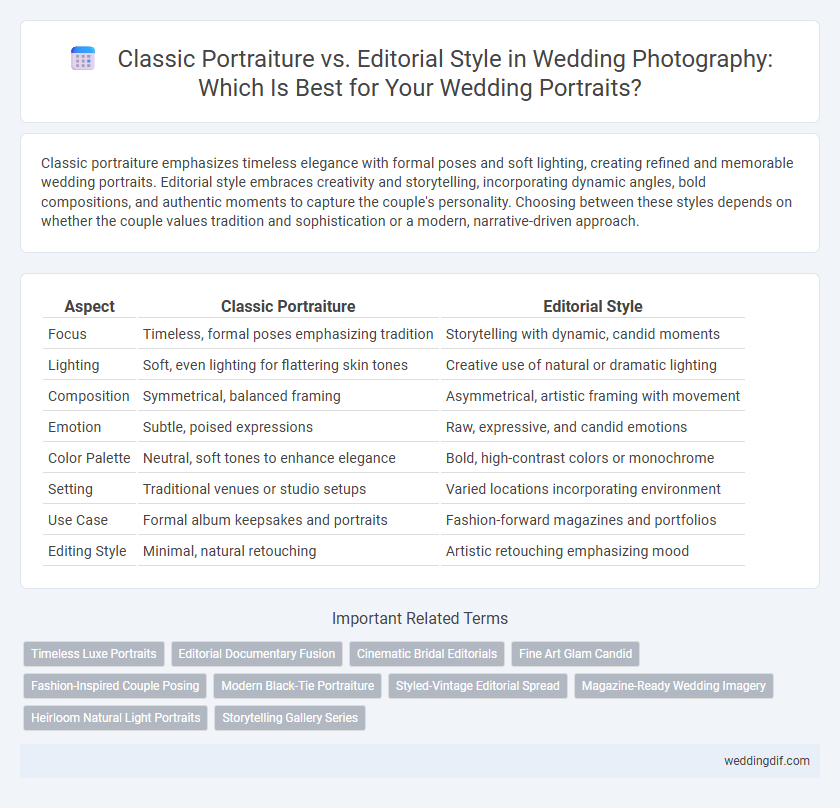Classic portraiture emphasizes timeless elegance with formal poses and soft lighting, creating refined and memorable wedding portraits. Editorial style embraces creativity and storytelling, incorporating dynamic angles, bold compositions, and authentic moments to capture the couple's personality. Choosing between these styles depends on whether the couple values tradition and sophistication or a modern, narrative-driven approach.
Table of Comparison
| Aspect | Classic Portraiture | Editorial Style |
|---|---|---|
| Focus | Timeless, formal poses emphasizing tradition | Storytelling with dynamic, candid moments |
| Lighting | Soft, even lighting for flattering skin tones | Creative use of natural or dramatic lighting |
| Composition | Symmetrical, balanced framing | Asymmetrical, artistic framing with movement |
| Emotion | Subtle, poised expressions | Raw, expressive, and candid emotions |
| Color Palette | Neutral, soft tones to enhance elegance | Bold, high-contrast colors or monochrome |
| Setting | Traditional venues or studio setups | Varied locations incorporating environment |
| Use Case | Formal album keepsakes and portraits | Fashion-forward magazines and portfolios |
| Editing Style | Minimal, natural retouching | Artistic retouching emphasizing mood |
Understanding Classic Portraiture in Wedding Photography
Classic portraiture in wedding photography emphasizes timeless composition, natural lighting, and posed yet relaxed subjects to capture the elegance and formality of the occasion. This style prioritizes clear, flattering images that highlight the bride and groom's features while preserving traditional aesthetics. Understanding classic portraiture helps photographers create enduring wedding portraits that remain cherished heirlooms over time.
Defining Editorial Style for Wedding Portraits
Editorial style wedding portraits emphasize storytelling through candid, narrative-driven images that capture authentic emotions and moments, often reflecting fashion magazine aesthetics. This style incorporates dynamic compositions, dramatic lighting, and creative posing to evoke a sense of drama and sophistication. Unlike classic portraiture, which prioritizes posed and timeless images, editorial style prioritizes mood, movement, and artistic expression in wedding photography.
The Aesthetic Differences: Classic vs. Editorial
Classic portraiture in wedding photography emphasizes timeless elegance, featuring posed compositions, soft lighting, and traditional backgrounds to capture the bride and groom's refined beauty. Editorial style adopts a more dynamic and fashion-forward approach, using dramatic lighting, unconventional angles, and candid moments to create visually striking and narrative-driven images. The aesthetic differences lie in classic's polished formality versus editorial's artistic expressiveness, catering to distinct storytelling preferences in wedding albums.
Posing Approaches: Traditional vs. Candid Storytelling
Classic portraiture emphasizes structured, timeless poses with a focus on symmetry and formality, creating elegant and refined wedding portraits. Editorial style prioritizes candid storytelling through natural, dynamic poses that capture genuine emotions and spontaneous moments. This contrast in posing approaches shapes the overall narrative, with classic portraiture offering polished sophistication and editorial style delivering authentic, narrative-driven imagery.
Lighting Techniques in Each Style
Classic portraiture in wedding photography utilizes soft, natural lighting or controlled studio setups to create timeless, flattering images with balanced shadows and highlights. Editorial style embraces dramatic lighting techniques, such as high contrast, directional light, and creative shadows, to add depth and storytelling elements. Mastery of these lighting approaches ensures wedding portraits align with the desired aesthetic, whether elegant or fashion-forward.
Editing and Retouching: Subtle Versus Stylized
Classic portraiture editing emphasizes subtle retouching techniques that enhance natural skin tones and preserve authentic expressions, maintaining a timeless and elegant look. Editorial style wedding portraits incorporate more stylized editing, including dramatic lighting adjustments, color grading, and creative effects to produce visually striking, fashion-forward images. The choice between subtle and stylized retouching directly impacts the final aesthetic, influencing how emotions and details are conveyed in wedding photography.
Emotional Tone: Timelessness vs. Modern Fashion
Classic portraiture for wedding portraits emphasizes a timeless emotional tone, capturing enduring expressions and traditional poses that evoke lasting memories. Editorial style, by contrast, reflects modern fashion trends with dynamic compositions and expressive storytelling, highlighting the couple's personality and current aesthetics. Each approach shapes the emotional resonance, either preserving classic elegance or showcasing contemporary vibrancy.
Client Expectations for Portrait Styles
Clients seeking classic portraiture for wedding portraits expect timeless, formal poses that emphasize elegance and traditional beauty, capturing moments with a refined, polished aesthetic. Editorial style clients prioritize creative storytelling with dynamic compositions, modern lighting, and candid emotions that reflect personal style and individuality. Understanding these expectations allows photographers to tailor approaches that satisfy the desire for either timeless sophistication or contemporary, narrative-rich imagery.
Choosing the Right Style for Your Wedding
Classic portraiture emphasizes timeless, posed images with soft lighting and traditional compositions that highlight elegance and emotion. Editorial style captures candid moments with creative storytelling, dynamic angles, and dramatic lighting to reflect contemporary trends and personal narratives. Selecting the right wedding portrait style depends on your preference for either timeless refinement or expressive, fashion-forward visuals that tell your unique love story.
Blending Classic and Editorial Elements for Unique Results
Blending classic portraiture's timeless compositions with the dynamic, storytelling approach of editorial style creates wedding portraits that are both elegant and emotionally engaging. Utilizing precise lighting and traditional poses alongside candid, fashion-inspired moments enhances the visual narrative, capturing authenticity and sophistication. This fusion allows photographers to deliver unique wedding images that resonate with personal significance and high-impact aesthetics.
Classic Portraiture vs Editorial Style for wedding portraits. Infographic

 weddingdif.com
weddingdif.com